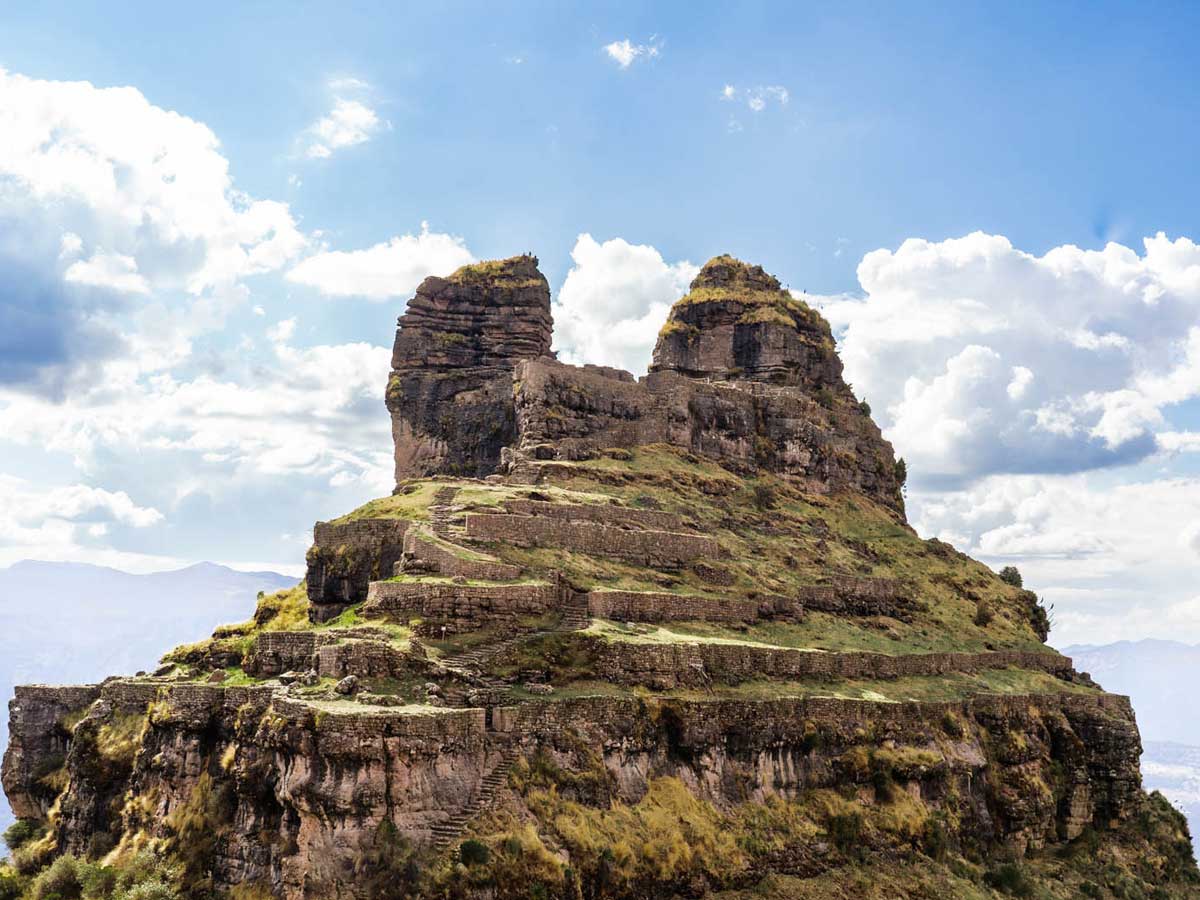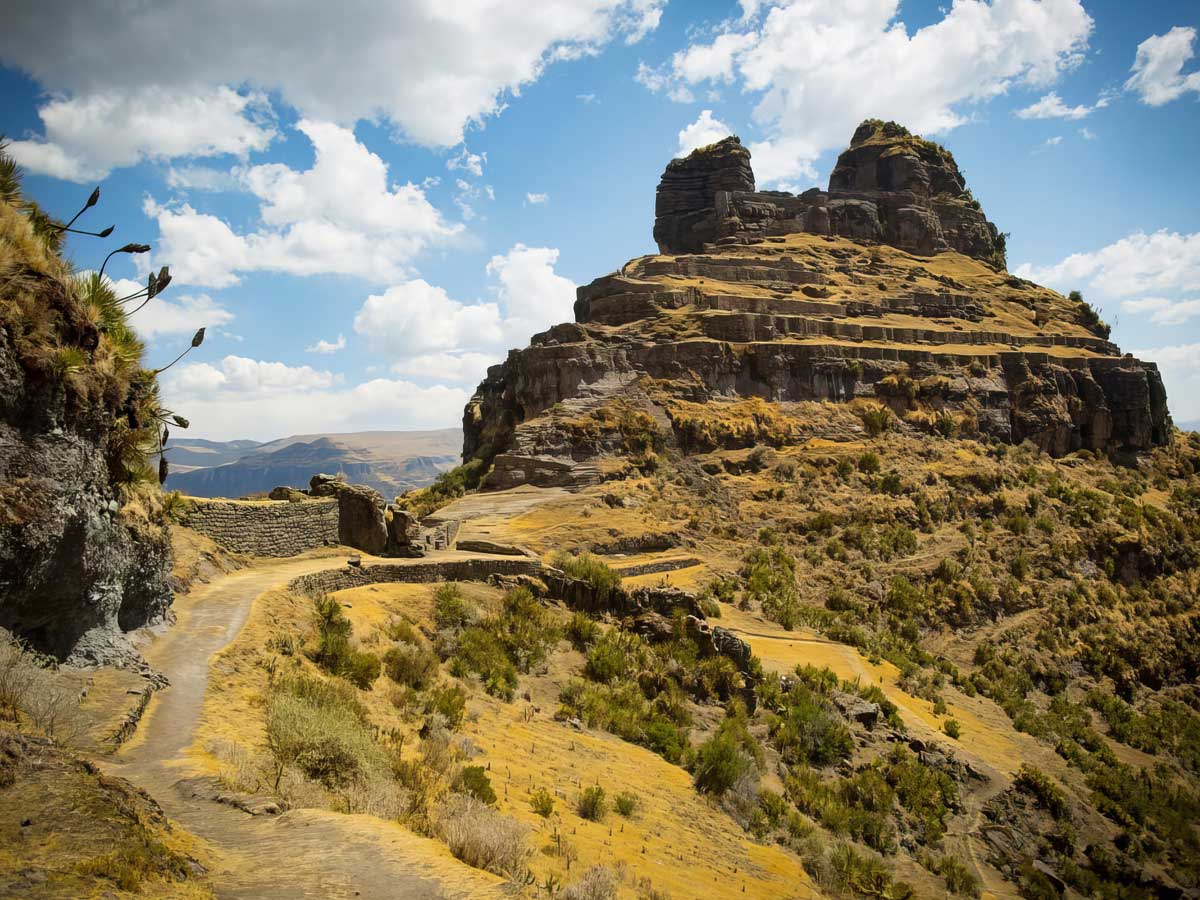

Cusco is par excellence the most important historical destination in Peru and it is the one that attracts the most tourists. However, few know that this city offers many more attractions besides Machu Picchu. One of these is the Waqrapukara fortress.
Waqrapukara represents a great alternative for those looking for a different adventure during their stay in the city of Cusco, with its pristine and impressive landscapes, which start from wonderful lagoons, to get lost among the mountains, streams, and rocky walls of this part of the Apurimac Canyon. Find in this post all the necessary information to be able to visit this impressive place.
The archaeological center of Waqrapukara, territorially belongs to the district of Acos of the province of Acomayo in the department of Cusco Peru and is located at an approximate height of 4140 meters above sea level.
The denomination, Waqrapukara, seems to be in current use when translated as strength of the horns, making a clear allusion to the horns of the cattle that is of recent presence in the environment, in addition, there is perhaps a previous denomination among the population, LlamaPukara, which would translate as flame fortress, which would reveal a much more coherent analogy with the local culture, there is also the name Llaqtapukara, which would translate as "people's barracks", which perhaps alludes to the place, as the last refuge of the resistance that the Qanchis people opposed to the Inca empire and finally we can quote the Archaeologist Miguel Cornejo who, beyond a linguistic interpretation, indicates that the place represents "the architecture of Power"
Waqrapukara was an important religious and administrative center occupied by various Andean cultures over time. The first to inhabit it would have been the Qanchis, an ethnic group from southern Peru that, according to the historian Luis Barreda Murillo, appeared around 2500 B.C. in the pre-ceramic period. During that stage, they worshipped the god Teqsi Pachacamaq Wiraqocha, as recorded by Guamán Poma de Ayala. Later, the Incas conquered the Qanchis, incorporating the place into their territorial control network while continuing to respect its ceremonial use, a common practice of the Tahuantinsuyo with the peoples that integrated the Inca empire.
During the Inca period, Waqrapukara was also the scene of conflicts. A chronicle mentions a rebellion of the Qanchi people against the Inca Wayna Qapaq for the increase in textile tributes. The leader of the revolt, Ttito Qosñipa, resisted for months from this site, probably strengthening its defenses with the two watchtowers that are still preserved. Another less warlike version tells that, after being defeated, the Inca forgave the rebel leader, joined him to his army, and gave him a ñusta as a wife, integrating him into the state apparatus.
As part of its symbolic importance, Waqrapukara was declared an official sanctuary of the Sun god. It is currently one of the most unique destinations in southern Peru, not only for its history, but also for its architecture adapted to a mountainous environment with difficult access. Since July 17, 2017, it has been part of the Cultural Heritage of the Nation, which guarantees its preservation and positions it as a cultural and natural attraction for visitors.

The allure of Waqrapukara lies in its enigma and mystique, yet much of the historical information surrounding the site remains speculative. Given its relatively recent discovery, the true nature of these stones continues to be unraveled, creating an atmosphere of great anticipation. What insights have we gained thus far into this extraordinary location? How old is it, and what purpose did it serve?
While the precise dating of the fortress remains elusive, intriguingly, it is believed to predate the Inca civilization by a significant margin. The narrative suggests that the site originally functioned as a petite citadel named Llaqta Pukara, constructed by and for the Qanchi people, possibly within the time frame of 1500 to 1000 BC.
During the era of the Inca Empire, particularly under the rule of Wayna Qhapaq, Waqrapukara was conquered, leading to the erection of new structures visible today. Historians posit that it was conceived as an astronomical observatory, accompanied by a sanctuary dedicated to the creator god Illa Teqci Pacha Kamaq Wiraqocha.
Research indicates that Waqrapukara was initially built by the Canchis culture and not by the Incas. The Canchis inhabited the southern territories of Cusco (current province of Canchis) parallel to the Incas. Both cultures competed for territorial control.
However, after the Inca vs. Chancas (1440 A.D.), the Canchis allied themselves with the Incas and formed part of the Collasuyo region, in the nascent empire of Tahuantinsuyo.
The construction date of Waqrapukara is still a mystery. The canchis must have built the first roads and enclosures in a few centuries before the formation of the Inca empire in 1438. It is estimated that under the government of the emperor Túpac Yupanqui (1471 – 1493) the main temples and platforms were built.
A remarkable aspect of the architecture of Waqrapukara is its temples with three jambs located in the highest part (in the central part of the stone mounds that form the ridges of the fortress). These types of buildings are present in few Inca sanctuaries of great importance such as Pachacamac (Lima) and Maukallacta (Arequipa).
The central structure of Waqrapukara (in the middle of the two horns) is constituted by a cavern with a window that shows the abyss on which it is formed.
The entire architectural complex of Waqrapukara is made up of enclosures, stairs, canals, platforms and more. In the lower part are the platforms, smaller enclosures and stairs that lead to the highest part. There, in the upper part, are the largest enclosures, the temples and the finest constructions (of the Inca elite).
The Waqrapukara fortress had great importance for the Andean worldview in the Inca era. Thus, "waqra" means horn and "pukara" means strength. However, for the Acos communities, this fortress is known as Llamapukara, as they claim that the horns are actually the ears of a llama that remains alert to the presence of foreigners.
Waqrapukara, likewise, is a first-class Inca sanctuary, this means that it had great political and religious power. Under these functions, it is made up of two groups of buildings. The first group is located in the highest area of the building. There are two groups of enclosures separated by a fairly large central space. These enclosures also have passages, double jamb portals and niches that function as ornaments.
The second group is located in the lowest area and is comprised of 8 terraces 150 meters long and 2 meters high. Like the first group, two rooms with double jambs and niches can be seen. However, 5 more enclosures are added that are located at the eastern end.
In addition to being a complex building, the beauty of the Waqrapukara fortress lies in the silhouettes of giants that can be seen. Built as a result of radical changes in temperature, rains and hailstorms, these silhouettes seem to protect the fortress.
Fun Fact: The rock formations surrounding Waqrapukara have been shaped by time, rain, and wind, and from certain angles they look like giant figures that silently watch over the fortress, as if they were petrified guardians of the past.

The Waqrapukara fortress is located in the district of Acos, in the province of Acomayo. To reach this archaeological destination you can choose between three Inca trails. To take any of these three routes, you must leave from the city of Cuzco.
To get to Cusco from Lima, you can use bus companies like Tepsa or Ferkaxi. The ticket price starts at 60 soles.
Unlike other destinations with many visitors, in Waqrapukara you can camp in the surroundings. I recommend enjoying the night sky. Perhaps you will find the reason why its ancient builders chose this magical and mysterious place.
The three routes you can take to get to the Waqrapukara fortress pass through Sangarará, through the community of Huayqui and through Santa Lucía.
To take the first route, you have to leave the city of Cusco in private mobility towards the district of Sangarará. Then, you have to take the detour until you reach the car park. From there the trek to Waqrapukara will begin. Since this route has an extension of 8 kilometers, the duration of the walk is 2 hours and 30 minutes one way and the return is approximately 3 hours and 30 minutes.
In addition to being the shortest route to the fortress, from Sangarará you will be able to observe the fauna of the Andes region. If you are lucky, you will be able to witness a large number of vicuñas walking around in their natural habitat.
The second route is to leave Cusco towards Acomayo, which usually takes 3 hours of travel. That is where the Huayqui community is located on the Huáscar branch. This route is comprised of a bridle path with an extension of 7.5 kilometers, so it will take you 1 hour to walk.
The third route is to take a bus or group that leaves from the city of Cusco and goes to the Acomayo turnoff, taking the direction of Sicuani. Arrived at the detour you must take a taxi or bus to Pomacanchi. From there you must go to Santa Lucía, which is 1 hour away.
All routes involve a walk that is usually long and uphill, so it is recommended to have a minimum level of resistance and experience in trekking.
The climate of the place corresponds to that of the entire region of Cusco with the two respective seasons that between May and October are in the cold - dry period and between the months of November and April in the rainy period, on the other hand, the winds can be constant and increase between the months of August and September due to the geography of the place.
Finally, temperatures can have a maximum of 19 degrees Celsius and a minimum of -6 degrees in the coldest and rawest nights.
Depending on the route you take, it is possible to travel a route that goes from moderate to strong, remember to take good care of yourself in the case of undertaking an adventure on your own.
The Waqrapukara festival is a cultural activity promoted every year by the local government of the district of Acos, this with the purpose of promoting the folkloric encounter and the cultural revaluation of the archaeological landscape of Waqrapukara. The activities consist of the staging of the already legendary Qanchis resistance against the Inca Wayna Qapaq, which is divided into 4 acts that are followed by around 15 typical dances of the region, which brighten the current festivity.
This activity is carried out in the month of August, being a perfect date for the visit to the place.
With a scheduled activity on a properly designed route, it is possible to cycle as part of the activities towards the archaeological center of Waqrapukara.
In the calm lagoons surrounding the route towards Waqrapukara it is possible to kayak as a complementary activity.
It can be done as a complementary activity and as part of the route to the attraction.
Waqrapukara is also a destination that can be visited on your own. To do this, you must take public transport to Cusipata (located on Huayruropata Avenue in the city of Cusco). Once there, you must take another public transport to the town of Sangarará. There begins the trek to the Inca archaeological site. The return trip takes the same return route.
Peru offers fascinating experiences that reveal natural landscapes, historical monuments, and living cultures, captivating those who seek adventure and discovery in every corner of its territory. Get to know the most outstanding tours:
If you want to visit Machu Picchu, we recommend you to book your Machu Picchu Entrance Tickets in advance, so you will enjoy your Vacation in Machu Picchu without any problem.